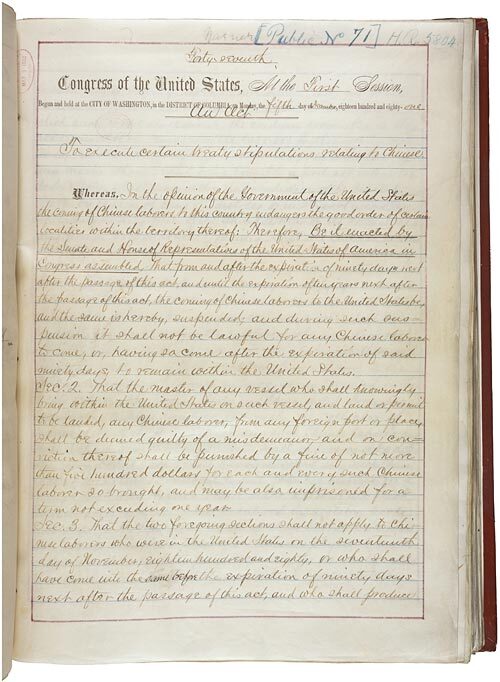Chinese Exclusion Act of 1882
The Chinese Exclusion Act of 1882 stands as a pivotal moment in U.S. history, marking the first federal law explicitly designed to restrict immigration based on race or ethnicity. Its passage was deeply rooted in the economic, cultural, and political climate of the late 19th century. During the California Gold Rush, Chinese laborers migrated to the United States in significant numbers, contributing to industries such as mining, agriculture, and railroad construction. Their hard work and willingness to take on difficult, low-paying jobs were instrumental in the rapid development of the American West. However, as the gold rush subsided and economic instability grew, resentment against Chinese immigrants began to escalate. White laborers, feeling threatened by what they perceived as unfair competition from Chinese workers willing to accept lower wages, began to push for exclusionary measures. This economic anxiety was compounded by deep-seated racial prejudices, with many Americans viewing the Chinese as an unassimilable "other," whose language, customs, and traditions were incompatible with the dominant culture.
This wave of anti-Chinese sentiment was further fueled by organized groups like the Workingmen's Party of California, whose rallying cry, "The Chinese Must Go," resonated with a growing portion of the population. Local governments in California had already implemented discriminatory laws, such as the Foreign Miners' Tax, which targeted Chinese miners disproportionately by imposing heavy fees. These sentiments ultimately culminated in federal action when Congress passed the Chinese Exclusion Act in 1882. The law banned Chinese laborers from immigrating to the United States and prohibited those already in the country from obtaining U.S. citizenship. Although certain exceptions were made for merchants, students, teachers, and diplomats, the vast majority of Chinese immigrants fell under the category of laborers and were thus barred. Originally intended to last ten years, the act was extended by the Geary Act in 1892 and remained in effect in various forms until it was repealed in 1943.
The consequences of the Chinese Exclusion Act were profound and far-reaching. It significantly curtailed Chinese immigration, leading to a sharp decline in the population of Chinese communities in the United States. This stagnation was compounded by the fact that many Chinese immigrants were single men who could no longer reunite with their families due to the restrictive laws, resulting in fragmented communities and generations of isolation. Additionally, the law institutionalized racial discrimination, reinforcing the notion that Chinese individuals were second-class residents ineligible for full participation in American society. Those who remained in the United States were subjected to harsh living conditions, violence, and exclusion from economic and social opportunities. Chinese immigrants were often confined to ethnic enclaves, such as Chinatowns, which became both a refuge from hostile environments and a symbol of their marginalization.
The act's legacy extended beyond the Chinese community, setting a dangerous precedent for future exclusionary immigration policies targeting other ethnic groups. It reflected and perpetuated the broader racial hierarchies of the time, shaping American attitudes toward immigrants for decades to come. Although the Chinese Exclusion Act was repealed in 1943 as part of a wartime alliance with China during World War II, its impacts lingered. The repeal did little to immediately rectify the damage inflicted on Chinese American communities, and full immigration reform did not come until the mid-20th century with the Immigration and Nationality Act of 1965.
Today, the Chinese Exclusion Act is remembered as a dark chapter in American history, illustrating the dangers of xenophobia and institutionalized racism. It serves as a sobering reminder of how economic fears and racial prejudice can converge to shape policy in ways that harm marginalized communities. By studying this period, we gain a deeper understanding of the struggles faced by Chinese immigrants and the resilience they demonstrated in the face of systemic discrimination. The act’s history continues to inform ongoing conversations about immigration, equality, and justice in the United States.
